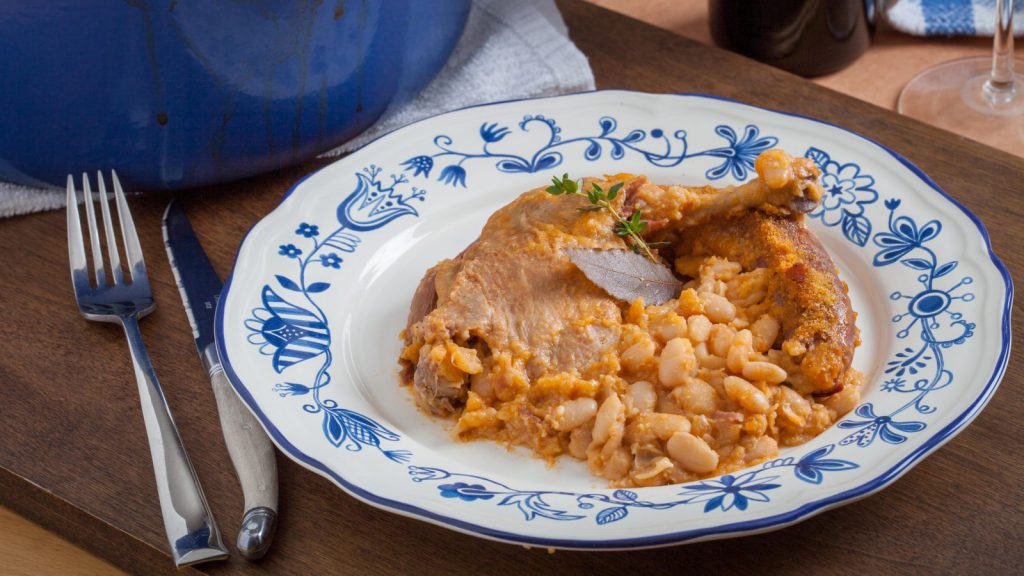Easy Duck Cassoulet
Cassoulet is a traditional dish from France's South West region made up of white beans and various meats including sausages, pork and duck confit. Try this easy to do recipe.
Servings: 4
Ingredients
- 1 pound white kidney beans
- 1 pound pork shoulder
- 2 tablespoons rock salt
- 2 tablespoons duck fat
- 1 sprig fresh thyme
- 2 medium bay leaves
- 1 medium carrot, peeled and cut in 4
- 1 medium onion studded with 8 cloves
- 1 medium green part of a leek
- 2 tablespoons tomato paste
- 6 cups chicken stocks
- 4 large pork sausages, Italian mild or Toulouse
- 10 slices bacon
- 4 medium duck legs confit
- 8 cloves garlic, finely chopped
- 1 cup breadcrumbs
- Salt and black pepper, to taste
Instructions
- Soak the beans overnight in 2 liters of cold water and reserve in a fridge for 8 to 10 hours. Rub the pork shoulder with one tablespoon of rock salt on each side and let cure in a fridge for 3 to 4 hours.
- Drain the beans and discard the soaking water. Place the beans in a large pot and cover with the cold water. Bring to a boil on high heat and boil for a minute. Strain and refresh the beans under cold water to stop them from cooking. Rinse the pot and put the strained beans back. Add thyme, bay leaves, carrots, eight cloves, green leek, and tomato paste. Cover the ingredients with 5 cups of chicken stock, put the lid on top and bring to a boil on high heat.
- When the beans are boiling, reduce the heat to medium. Cook for about 20 to 30 minutes, just until tender, but firm enough to stay together. When cooked, strain in a colander with a bowl underneath to collect the cooking liquid.
- In the meantime, rinse the pork shoulder under cold running water and dry it with a clean towel. Heat the duck fat in a sauté pan and sear the pork on all sides until golden brown, then set it aside. Do the same for the duck confit and the pork sausages.
- You are just searing the outside of the meat, to make it golden brown. Degrease and deglaze the pan with 2 cups of the bean cooking liquid to clean and dissolve the flavor of the pan. Preheat the oven to 350°F (if using a convection oven, bake at 25°F lower).
- Peel and chop the garlic, remove the aromatic garnish of the beans, but save the bay leaves for later use.
- Place the bacon slices on the bottom of a clay casserole or in an ovenproof dish, slightly overlapping them. Cover the bacon with a layer of beans, and then place in the center the pork shoulder, duck confit legs, chopped garlic, and the rest of the beans. Add the bean cooking stock and the remaining cup of chicken stock if needed. Place the sausages and bay leaves all around the top. Finally, season with salt and black pepper.
- Bake for 1 hour and 45 minutes. Test the beans; they should be cooked but not mushy. Sprinkle half of the breadcrumbs, and bake until golden brown. It will take 10 to 15 minutes. Then, break the thin crust and add the remaining breadcrumbs and bake for another 10 to 15 minutes at 450°F, until the top becomes crusty and golden brown.
- Remove from the oven and serve in the same dish with a glass of good red wine. A Madiran would be an excellent choice.
Notes
What is Cassoulet?
- It is a typical traditional French dish. It is the central part of a meal, which consists of meat and vegetables. The Cassoulet has an ancient, familiar, accessible, and countrywide origin. In time, it has become this great dish, which distinguishes the glory of Castelnaudary and enhances its reputation more and more every day. Cassoulet is made of beans, Toulouse sausages, a piece of duck confit cooked in its fat, a piece of pork, pork rinds, and duck or goose fat. Everything is then baked in a casserole to glaze it.
- Once upon a time; thus could begin the legend of the Cassoulet. During the 100-year-old war (between 1337 and 1453), the inhabitants of Castelnaudary, who were besieged by the English, made a gigantic ragout, gathering all their reserves of beans and various meat: geese, pork and sausages. Perked up by this imposing dish, they victoriously pushed back the enemy. Since then, from the humblest family to official banquets, the capital of Lauragais has remained faithful to this tasty dish.

